Follow these 15 steps to kickstart a successful career in interior design
Starting a new career takes a leap of faith. To be truly successful, it helps to have a solid plan. This 15-point guide is here to show you how to become an interior designer without having to drop everything or risk it all.
Whether you’re just exploring your options or ready to dive in, this clear and practical guide will help you get going. Our expert tutors, who have all worked in the interior design industry, have helped create this article to give you a smarter starting point.
The interior design world is growing fast. A recent report from Technavio shows the global market is expected to grow by $34.01 billion between 2024 and 2029, so there’s real opportunity out there for new designers looking to build a successful interior design career.
1. Nurture Your Creativity
Interior design is easy, right? Not quite. A lot of creativity is required to truly succeed. Designers need imagination to look beyond what’s there and visualise how a space could look and feel.
If you can picture a stylish layout, flowing colours and a strong mood in even the dullest of rooms, then you’re thinking like a designer. That creative edge helps you offer something original, not just follow trends.
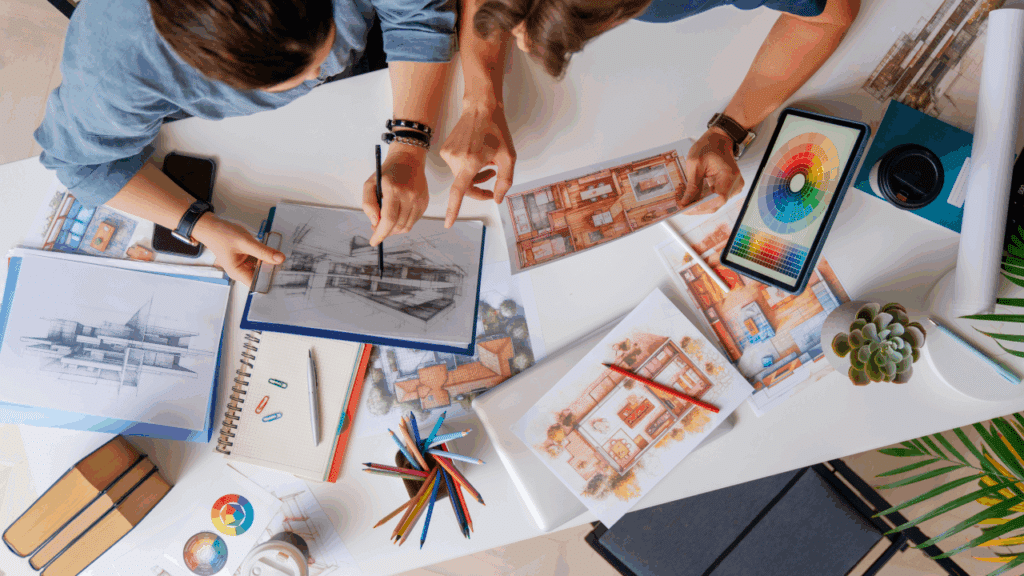
You don’t have to stick to interiors either. Many professionals in creative industries explore fashion, writing, art or jewellery making. Other hobbies tend to fuel your ideas and help you think outside the box. Once a creative, always a creative!
Another great tip? Keep a visual diary. This is a scrapbook or folder of ideas, inspirations, and design references. Capture everything! From brilliant concepts to random street snapshots. You’ll build a valuable toolkit to use when designing later.
2. Go Back to School.. Literally
Sure, interior design is creative and glamorous, but it’s also a serious profession that needs to be backed by solid knowledge and expertise.
If you want to be taken seriously, and have the confidence to win clients, you’ll need solid training.
A great interior designer doesn’t just make a space look good. They understand how to make it work for the people using it. That means knowing building regulations, creating safe layouts, and choosing the right materials for the job.
You’ll also wear a lot of hats: creative problem-solver, space planner, project manager, and client communicator. Especially if you’re working freelance or solo, you’ll need a wide skill set.

So what should you study? Start with the basics; space planning, colour psychology, lighting design, materials, and furniture. Then layer on essential soft skills: managing timelines, budgets, and client expectations.
👉 You can build these skills through an accredited Diploma in Professional Interior Design or a BA (Hons) in Interior Design. These courses teach the theory and the real-world application of interior design.
Want to specialise in specific fields? Here are a few paths to explore:
- Love styling shop displays or visual storytelling? Retail Design could be your niche.
- Fascinated by heritage buildings and period restoration? Look into Heritage Interior Design.
- Prefer designing outdoor spaces or terraces? Our Design for Outdoor Living Degree might be a perfect fit.
- Drawn to exhibitions, pop-ups and event styling? Check out Exhibition Design.
No matter which direction you take, investing in the right interior design education will set you up for success and help you stand out within a competitive industry.
3. Show Your Personality Through a Winning Portfolio
Your portfolio is your golden ticket to getting noticed in the design world.
Let your style and personality shine through, even if you’re showing a mix of interior styles. Whether you want to highlight your versatility or focus on a niche, your portfolio should tell your design story clearly and confidently.
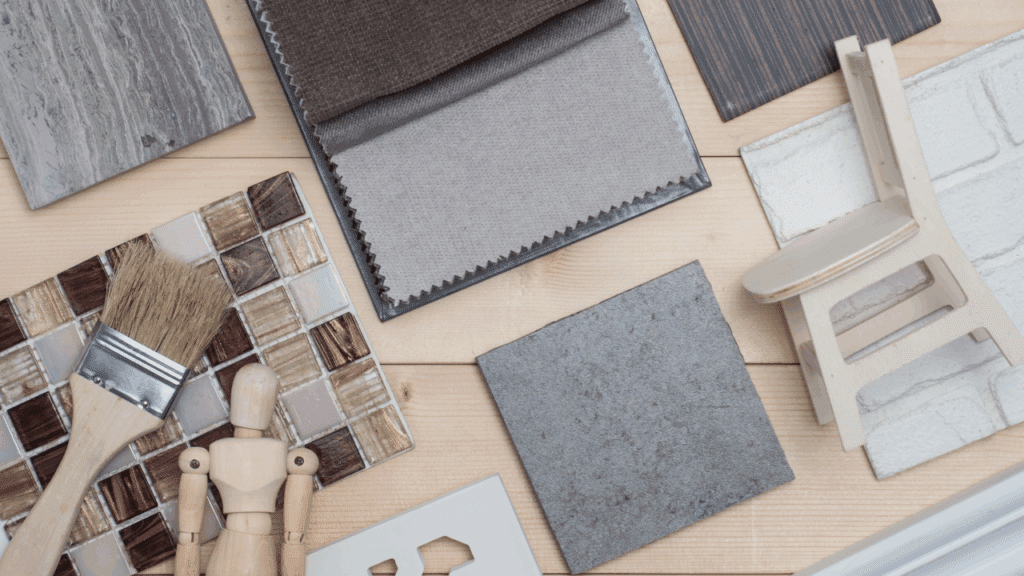
There are loads of free tools and templates online to help you get started. And if graphic design isn’t your strength, consider working with a designer to make your presentation stand out.
Put real effort into it. Your portfolio should showcase your best work, your creative thinking, and how you approach projects from concept to completion. Being proud of what you’ve created makes presenting it to clients or employers much easier.
Update it regularly with new projects, styles or techniques. And don’t skip feedback! Ask your tutors, friends, or industry contacts to give honest opinions. If you hear the same advice more than once, it’s probably worth acting on.
It could be a polished PDF, a digital flipbook, or even a short video. Whatever format you choose, make sure it’s professional, easy to share, and visually engaging.
💡 As an NDA student, you can also get access to a dedicated Portfolio Guide via the Virtual Learning Studio (VLS). It serves as a step-by-step resource that supports you in building a standout, industry-ready presentation.
4. Get Interior Design Experience (Any Way You Can)
So, you’ve got an interior design course under your belt. Your portfolio is taking shape. The next step to becoming an interior designer is to gain some experience.
It doesn’t have to be a professional job (yet) – just look for every opportunity to ‘learn by doing’!
Here are a few ideas:
- Redecorate your own home as a design challenge but make sure you go through the full process as you would for a client.
- Ask friends if you can help redesign their homes for free – you may get quite a few takers so don’t offer to everyone all at once!
- Spread the word in the community that you’re offering free design services. You could even use social media platforms such as Instagram to offer your services as a prize.
The more experience you get, the more you’ll create contacts, learn on the ground, and slowly build your reputation. Think of this as a trial run with slightly less pressure than with paid work (but you’ll still need to deliver the goods on the project!).
You can also apply for internships at companies or ask to shadow an established designer, even if this involves doing menial tasks. The trick is to be passionate and persistent – even internships can be hard to secure these days and again, your portfolio will help you to stand out from a large list.
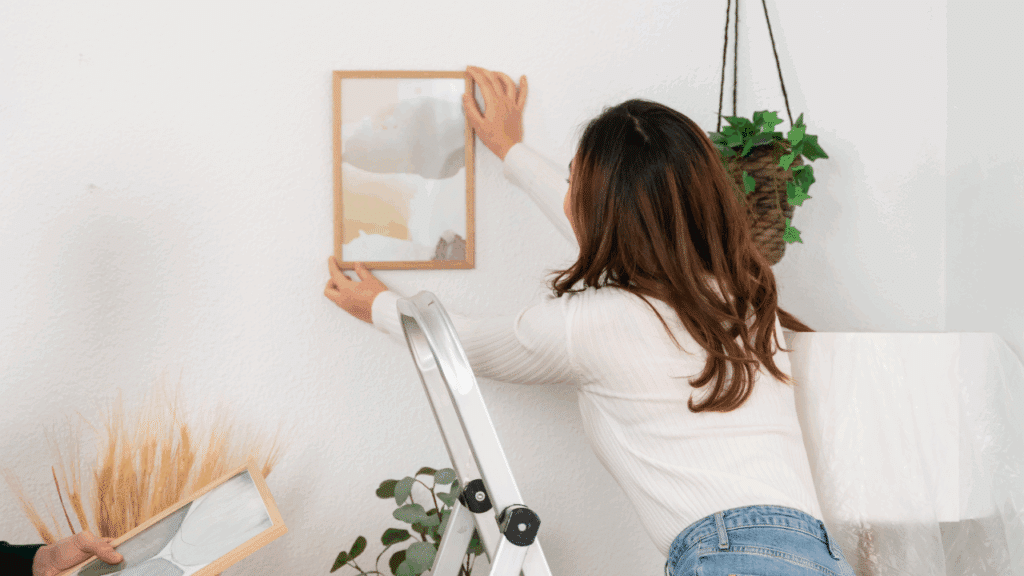
The best part is that you can get invaluable exposure and find new opportunities just by being in the right environment and soaking up all the learning you can.
5. Create Connections
In interior design, your network is everything. Many interior designers get their first few jobs through friends, family or social contacts. So get your name out there!
Tell people what you do, share projects online, and promote your design journey. A single Instagram post or conversation could lead to a referral.
Professional networking matters too. Join associations, attend exhibitions or local meetups, and connect with people in the industry. Build your own network of suppliers, collaborators and mentors.

And it goes without saying that if you’re shy by nature, you’ll need to step out of your shell in order to create these new connections and increase your chances of success.
Again, this is where social media can be a great tool to help you become an interior designer. Use your portfolio or inspiration to gain followers who may turn into clients.
Creating connections also extends to building up your own services. Look to proactively build an extensive network of suppliers and partners who can satisfy different project requirements and help you offer a wider scope of services.
Suppliers are a great source of referral business too, so always be nice to those you meet on the way up!
6. Understand the Market
To build a long-term career in interior design, you need to understand where the demand is, both locally and globally.
Is your area experiencing regeneration or a housing boom? Are businesses investing in modern offices or eco-conscious fit-outs? Identifying market trends helps you tailor your services to what’s in demand.
Interior design is closely tied to construction, hospitality, retail and residential development. Stay aware of shifts in these sectors to spot opportunities.

Understanding the stability or growth of specific industry sectors and geographic regions in both the short and long term can guide you on what route to follow.
Another must-do? Keep up with trends.
For example; there’s been great interest in merging the ideals of different spaces – such as blending indoors with outdoors, or blurring the lines between commercial and residential (now known as ‘resimercial’ design).
It’s also important to understand sustainable, ethical and wellbeing issues, which are a key focus in all design fields.
Doing this can be an immense learning curve, but it can make a real difference to the planet, to others involved in the design process, and to those that will use the spaces you design.
Subscribing to online industry newsletters and following influencers on social media is a great way to do this and to ensure that your design approach aligns with what’s happening around you.
Reading interior design magazines and digests, whether online or printed, can also help you stay up to date with key interior design trends. We suggest you start with these:
💌 You can also Join our Mailing List to get regular trend inspiration, course updates, and career tips straight to your inbox too!
7. Look at the Big Picture
When it comes to design evolution, the world of interior design overlaps greatly with other creative industries.
This means that Interior design doesn’t exist in a vacuum. It’s part of a larger creative world that includes fashion, film, music and culture. Trends often ripple across these industries.
If you want to stay ahead of the curve, observe what’s happening in other creative spaces.
- What colours are dominating fashion runways?
- What moods are coming through in art and photography?
Designers who understand these bigger cultural shifts are more likely to create forward-thinking, future-proof spaces.
And don’t forget the crossovers: many interior designers collaborate with architects, lighting experts, furniture makers, and brand specialists – to name a few. Learning from other disciplines makes your design thinking stronger.
8. Identify Your Niche
Now that you understand the market, it’s time to find your place in it.
Do you want to design high-end homes, work on retail interiors, or specialise in eco-friendly tiny houses? Finding a niche helps you focus your efforts and speak to a specific audience.
You might position yourself by:
- Client type (residential, commercial, hospitality)
- Style (boho, Scandi, maximalist)
- Location (urban, rural, coastal)
- Service model (consult-only, full-service, sourcing-only)
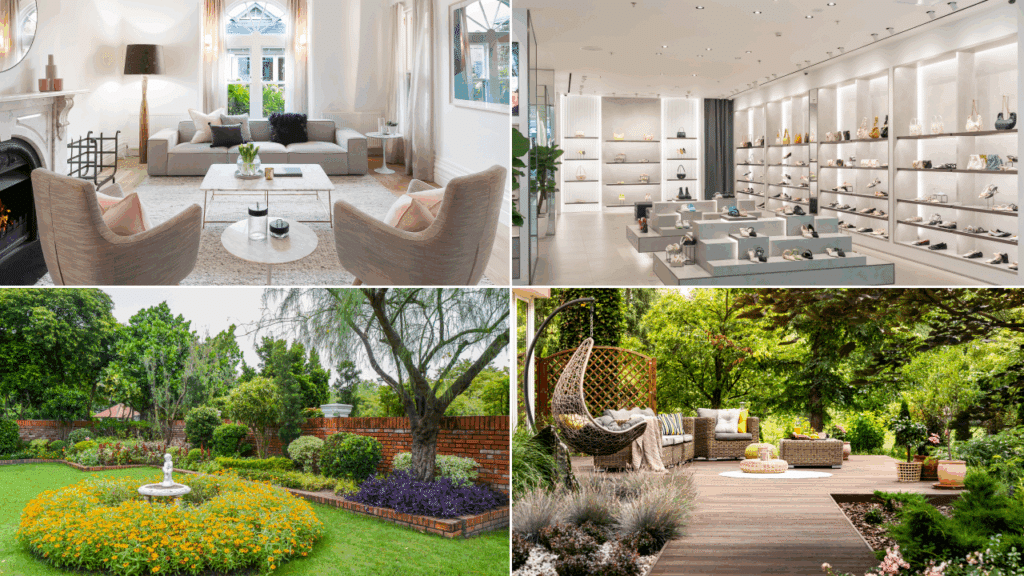
Within your sector, look at what competitors are offering and what you can do differently. This can be in the type of services you offer, or how you work and charge your fees.
Niche doesn’t mean small. It means targeted, and that makes it easier for clients to find and trust you.
💡Tip : Our BA (Hons) Interior Design gives you a broad foundation across multiple design sectors; including residential, commercial, hospitality, heritage and more. From there, you can top up with specialised modules once you’ve found your niche.
9. Find Your Own Voice
Branding matters, even for freelancing. Your visual identity, language, tone, and online presence should reflect your design style and personality.
Start by asking: who do I want to attract? What type of projects light me up?
Then make sure your branding i.e.; logo, portfolio, social media, website, tells that story. Even your Instagram captions and colour scheme play a role in setting the tone.
What you say is important, too. Define what sets you apart and weave it into your bio, posts, and conversations.
And above all, be consistent. Whether you specialise in luxury interiors or minimal eco design, your digital presence should match that vibe.
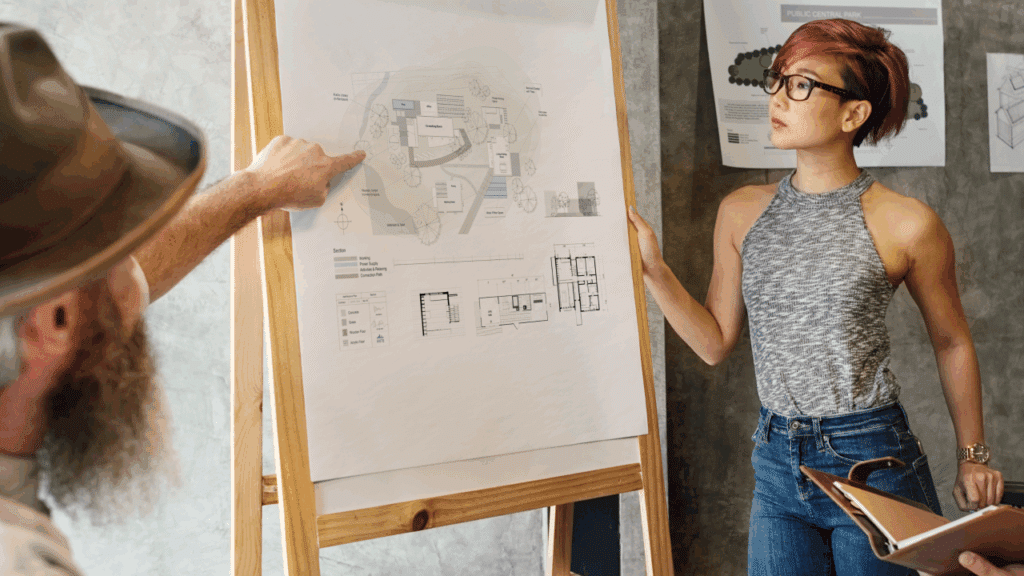
10. Toot Your Own Horn!
You may be the best interior designer out there, but if people don’t know about you, your awesomeness is going to waste!
Share project stories, behind-the-scenes clips, and before-and-after shots. Use Instagram, Facebook, and Pinterest to build your visibility.
If writing comes naturally, you can also write LinkedIn articles or blog posts about current trends, and even enter interior design competitions in the UK to get your name out there. These are great ways to build credibility and attract potential clients or employers.
And remember, people connect with people. Don’t be afraid to show your face, your design process, and your personality.
11. Brush Up on Your Digital Skills
We know you have Pinterest and Instagram nailed, but are you up to speed with the industry digital tools?
Design tech is essential in today’s interior design practice. You’ll need to get confident with tools like AutoCAD, SketchUp, and Enscape to create professional 2D and 3D visualisations.
These tools help you design faster, present ideas clearly, and collaborate with clients and contractors. They’re standard across the industry.
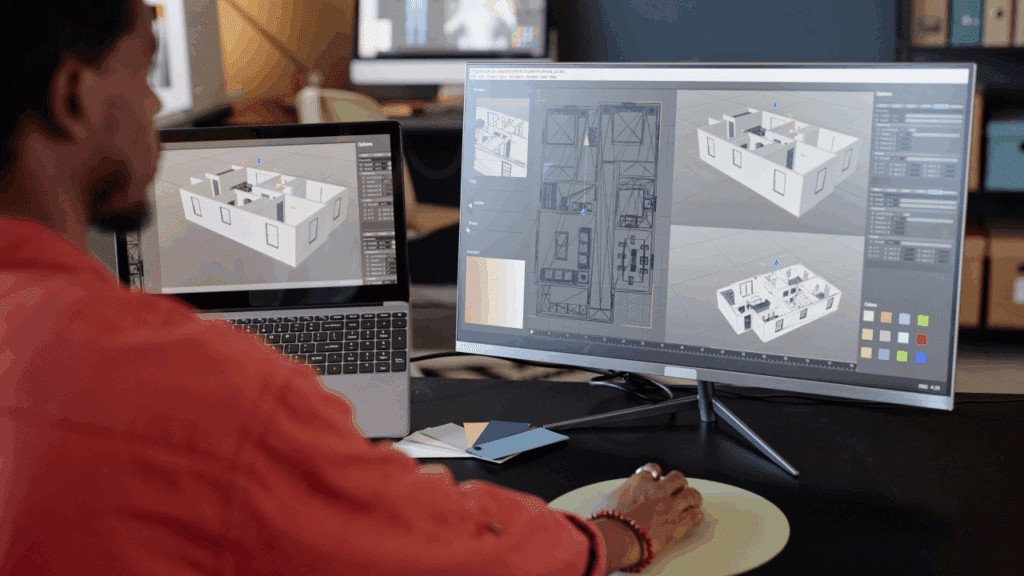
While tools like Revit and 3ds Max are used in large practices, most freelance designers rely on SketchUp and AutoCAD as their go-tos.
💡Tip: The National Design Academy offers a dedicated Interior Design Software Short Course in AutoCAD, SketchUp, and Enscape, perfect for new learners or those looking to refresh their skills.
This flexible online short course is ideal if you want to master the tools the industry uses every day. Find out more on our Interior Design Software Course page.
12. Become a ‘People Person’
This doesn’t mean you need to become a social butterfly… but you do need to understand that interior design is less about fabrics and colours and more about people.
It’s important to understand that interior design is a people-first profession. Every space you create is for someone else to use, so understanding people is key.
Spaces are designed for people to use, after all. That’s why so much of the success of a design plan comes not from how it looks, but from how much it fits in with the client’s personality and lifestyle. This applies equally to commercial and retail spaces that have corporate guidelines and brand values to abide by.
Developing an intuitive sense for what people would like is invaluable to your work, as is learning how to manage them and their expectations. Clients can be indecisive or become difficult to work with. If you do want to become a good interior designer, you need to be a good listener and pick up on clues on their personalities, tastes, and their satisfaction with how the project is progressing.
Communicate clearly and regularly, and deal with issues before they become crises.
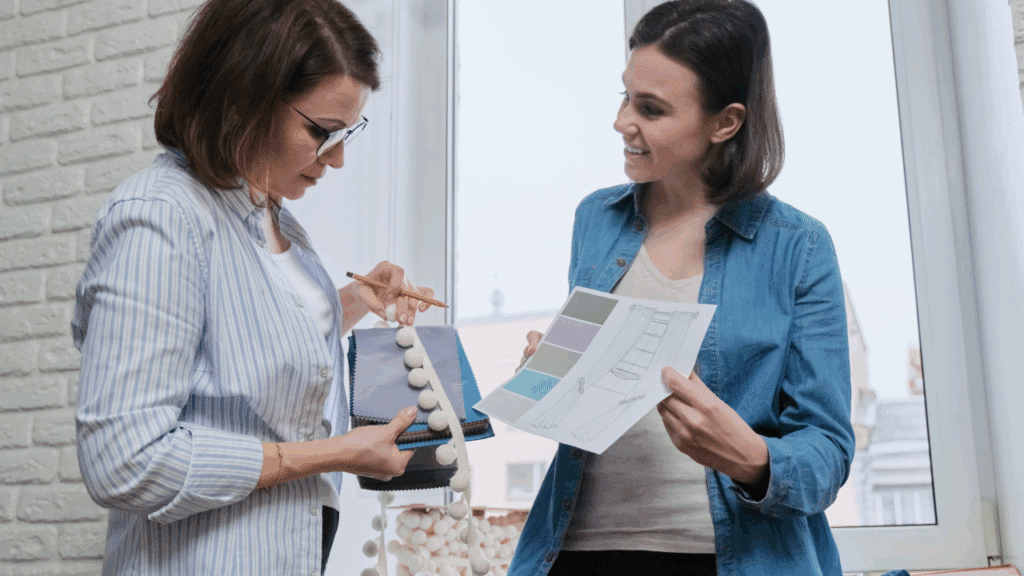
Remember that the client has placed their trust in you and your vision, so it’s important to genuinely care about how they’ll benefit from your design once it’s brought to life.
On the other extreme, bending to a client’s every whim can result in a disjointed, impractical or unattractive scheme. A degree of firmness is needed when working with clients, since you are the expert in the situation.
In addition to clients, interior design also involves working smoothly with a variety of specialists like suppliers, project managers, graphic designers, marketers, as well as furniture, lighting and garden designers.
The success of any project will greatly rely on the level of teamwork and communication involved.
13. Nail That Interview or Meeting
A slick portfolio and packed CV will get you through the door, but it’s your personality that will seal the deal and win over an employer or client.
Giving off the wrong vibe can discourage others from wanting to work with you, even if you’re a better designer than other candidates.
Again, interior design is all about people…
“Be confident, professional, positive and passionate in your interviews, and allow some of your personality and point of view to come through.”

Being unprepared for an interview or client presentation is one of the quickest ways to make a bad impression.
If you’re applying for a job, take the time to research your interviewer – including the company, its competitors, and the market it operates in – and try to come up with some ideas or recommendations. If you’re not interested enough to do this, then you won’t seem very keen for the job.
Try to get as much interview or presentation practice as you can. This will get you comfortable with the idea of having your behaviour and skills assessed by others, and also help you understand the impression you’re making. It’ll also help you get used to having your work critiqued or questioned without feeling defensive – one of the most important things for any designer to master!
There’s also plenty of free advice online on how to improve skills for job interviews and client presentations – including using chatgpt as well!
💡 Tip – At the NDA, students can also get guidance from tutors with real design experience. Whether you’re preparing for an interview, polishing your pitch, or refining how you present your portfolio. Many of our tutors work in the industry and understand exactly what employers/clients look for.
14. Seek Partners for Projects
Have you noticed how practically every new song or fashion collection right now is a ‘collab’ between two artists?
Collaborations are the order of the day and interior design is no exception.
Collaborating with a similar designer can strengthen your brand position and establish you as an expert in your area.
Think of it as building your brand by association. Alternatively, you could partner with a very different designer to get exposure to a wider and otherwise inaccessible audience.
This also adds an element of uniqueness and surprise.

You can even go across sectors or industries and partner with a garden designer, furniture designer, product designer, or lighting specialist… or any artist that shares your brand values.
Some very successful practices started as collaborations between architects and interior designers or textile designers and interior specialists.
Do this and you’ll learn more, find new connections and opportunities, and hopefully find an ally and someone to bounce ideas off for the rest of your career!
15. Become a ‘Forever Learner’
There’s never a dull day in the life of an interior designer.
Styles evolve, trends are cyclical, technologies advance and the challenge for a sustainable future is always intriguing.
To ensure that you never run out of work, you need to become an interior designer who stays at the very cutting edge of their craft.
As with any career you pursue, continuous learning and development will help you stay on top of changes in your industry and ensure your knowledge and skills are up-to-date.
Doing this also elevates your skills and enables you to take on more senior roles. Because let’s face it, you probably don’t want to get stuck doing the same thing for years with no career progression.
So how to keep your evolution going you ask?
Well, you can look at learning or improving specific skills or diversifying into a new specialism, or simply look at taking your education to the next level!

For example, you might start your career with a Professional Interior Design Diploma. And once you’ve built some experience, it’s worth considering a Bachelor’s Degree to deepen your expertise, boost your professional credibility, and expand your client base.
At the National Design Academy, many of our students do exactly that—progressing from Diploma to BA (Hons), and later moving into a Master’s Degree when they’re ready to lead on large-scale projects or move into senior design roles.
Our step-by-step study pathways are designed to evolve with you. Whether you’re just starting out or ready to specialise further, we support your development at every stage with flexible study and expert tutors guiding you all the way.
So wherever you are in your design journey, stay curious, keep building your skills and take our advice, never stop growing.
So, You Still Want to Become an Interior Designer?
There’s no one path to success, but taking small, strategic steps will get you there.
Start where you are. Take action when and where you can. Keep building skills, creating connections, and pushing your creativity.
And if you’re ready to study, our myriad of courses are built to support flexible, real-world based learning with expert tutor support.
Your dream career in design? It’s totally possible. So let’s get started!

